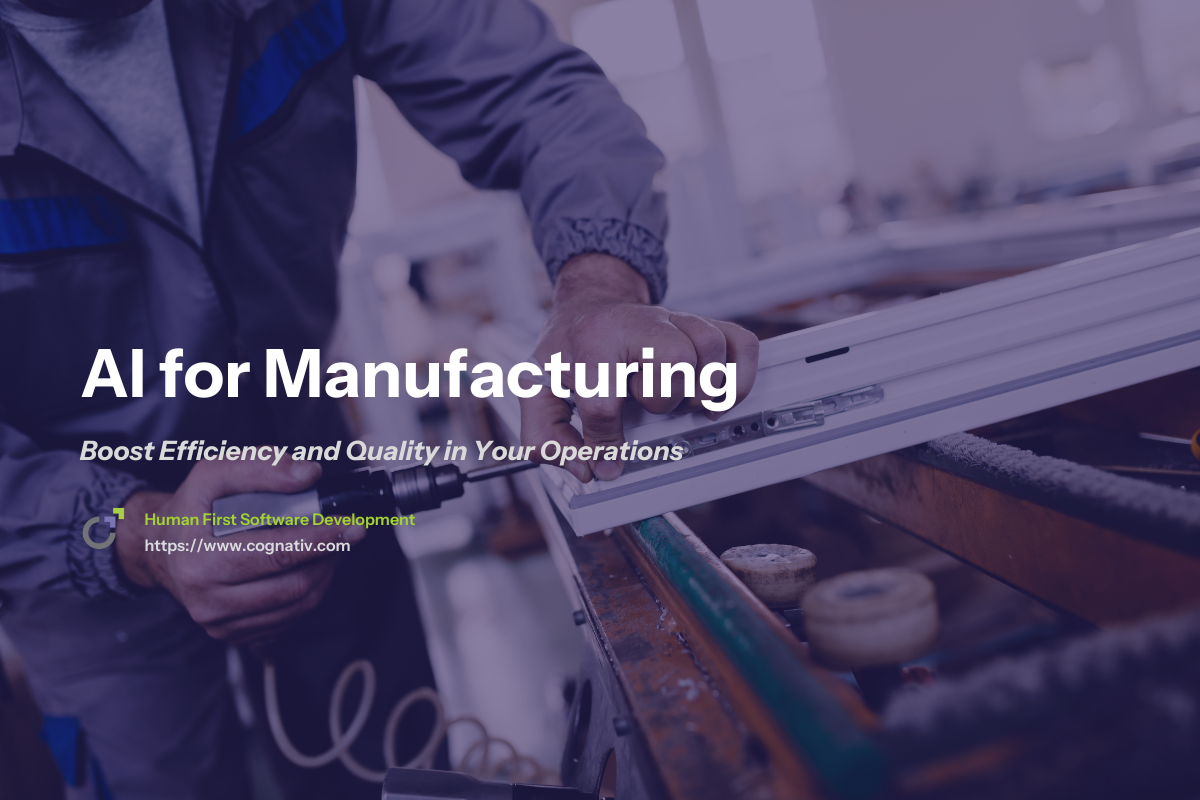

Monday, October 20, 2025
Kevin Anderson
AI for Manufacturing: Boost Efficiency and Quality in Your Operations
The manufacturing industry is undergoing a rapid digital transformation, fueled by artificial intelligence. As global competition intensifies and product lifecycles shorten, manufacturers are integrating AI technologies to optimize manufacturing processes, improve quality control, and build more agile production systems.
AI is transforming the business world at large, driving efficiency and innovation across industries. In manufacturing specifically, AI in manufacturing is enabling real-time decision making, predictive insights, and adaptive production environments. By analyzing massive datasets from the shop floor, sensors, and supply networks, AI systems uncover inefficiencies, prevent failures, and create smarter workflows.
For modern manufacturing companies, adopting AI is no longer optional—it’s essential to achieve a competitive edge, operational resilience, and sustainable growth.
Key Benefits of Artificial Intelligence in Manufacturing
AI for manufacturing offers numerous advantages that help companies enhance productivity, reduce costs, and maintain a competitive edge.
1. Automation and Workforce Optimization
AI-powered systems handle repetitive tasks, allowing human workers to focus on strategic, high-value activities.
Automated visual inspections using computer vision reduce human error and improve throughput.
Intelligent scheduling reduces bottlenecks across the production line.
Training employees to use AI tools for data analysis, decision-making, and process optimization enhances workforce capabilities and supports seamless integration of artificial intelligence technologies.
2. Cost Reduction and Quality Improvement
AI models analyze historical sales data and market trends to optimize material flow and reduce waste.
Continuous monitoring of assets improves predictive maintenance, extending equipment life and reducing maintenance costs.
Quality deviations are detected early, driving improved quality control and fewer recalls.
AI-driven systems optimize the use of raw materials, minimizing material waste and supporting sustainability initiatives in manufacturing processes.
3. Supply Chain Optimization
AI enhances supply chain management through better demand forecasting and supply chain efficiency.
Automated procurement and production planning minimize downtime and overstocking.
Real-time insights enable manufacturers to adapt quickly to changing demand patterns.
By analyzing historical sales data, AI improves demand forecasting and inventory management, helping predict customer demand, optimize production schedules, and reduce risks of overproduction or stockouts.

Implementing AI in Manufacturing Operations
Adopting AI solutions requires strategic alignment between technology and business objectives.
Identifying High-Impact Areas: Target processes where AI can deliver measurable ROI — such as production processes, logistics, or quality control. Incorporating AI into manufacturing operations automates repetitive tasks, improves quality control, and enables predictive maintenance, driving efficiency and innovation.
Integrating AI Systems: Seamlessly connect ai powered systems with MES, ERP, and SCADA platforms for real-time feedback loops.
Leveraging Real-Time Data: Use analyzing data from sensors and machinery to guide operational decision making.
Augmenting with Robotics and Vision: Combining AI with computer vision and collaborative robots (cobots) enhances automation at the shop floor level.
This structured approach ensures that implementing AI strengthens—not disrupts—existing manufacturing operations.

Optimizing the Manufacturing Process with AI
The manufacturing process spans multiple phases — from product design and material sourcing to assembly and delivery. AI in manufacturing improves efficiency at every step. During the assembly phase, especially in electronics manufacturing, AI and cobots enhance the assembly process by improving efficiency and accuracy in tasks such as component placement:
Production planning: Predict demand and optimize production processes to match capacity with market signals.
Product design: AI streamlines the design process, enabling rapid product customization, generative design, and more efficient prototyping.
Inventory management: Minimize waste through smart material tracking and supply chain optimization.
Predictive maintenance: Anticipate failures, reduce downtime, and stabilize operations.
Quality control: Detect defects in real time with computer vision systems, enabling immediate corrective action.
Process optimization: AI algorithms continuously fine-tune machine parameters to ensure peak efficiency.
This level of insight enables manufacturers to achieve cost savings, accelerate throughput, and boost customer satisfaction.

Machine Learning in Manufacturing
Machine learning is the backbone of modern manufacturing AI. It enables systems to learn from operational data and adapt over time:
Pattern Detection: Machine learning algorithms identify trends in production and manufacturing processes to reduce variability.
Predictive Insights: Models forecast component wear and supply volatility, improving predictive maintenance accuracy.
Continuous Learning: ML systems evolve with new data, improving precision over time.
Quality Control Automation: Algorithms detect anomalies and flag issues before they affect final output.
These capabilities support data-driven manufacturing companies that want to optimize efficiency and reduce risks.

Advanced AI Technologies Transforming Manufacturing
Advanced AI technologies are reshaping the manufacturing industry by bringing unprecedented levels of intelligence and automation to every stage of the production process. Machine learning, computer vision, and generative AI are at the forefront of this transformation, enabling manufacturers to optimize production processes, enhance quality control, and streamline supply chain management.
AI systems analyze data from a variety of sources—such as sensors embedded in machinery, real-time production metrics, and historical sales data—to identify patterns and predict outcomes. For example, predictive maintenance powered by machine learning allows manufacturers to anticipate equipment failures before they occur. By analyzing data from machines, AI systems can schedule maintenance only when needed, significantly reducing downtime and maintenance costs.
Quality control automation is another area where AI technologies excel. Computer vision systems inspect products on the production line, detecting even the smallest defects that might be missed by human eyes. This not only improves quality control but also reduces waste and ensures that only top-quality products reach customers.
Generative AI is also making its mark by optimizing product designs and suggesting innovative solutions for production challenges. By leveraging these advanced AI technologies, manufacturers can achieve greater efficiency, lower costs, and maintain a competitive edge in a rapidly evolving market.
Decision Making with AI: From Data to Actionable Insights
AI is revolutionizing decision making in the manufacturing industry by turning vast amounts of data into actionable insights. Modern AI systems analyze data from production processes, supply chains, and market trends to identify patterns and forecast future scenarios. This empowers manufacturing companies to make smarter, faster decisions that drive business success.
For instance, AI-powered systems can analyze historical sales data and current market trends to accurately predict future demand. This enables manufacturers to optimize production schedules, align inventory levels, and avoid costly overproduction or stockouts. By continuously analyzing data from across the supply chain, AI helps identify bottlenecks and inefficiencies, allowing companies to optimize efficiency and streamline operations.
AI-driven decision making also supports supply chain optimization by providing real-time insights into supplier performance, logistics, and raw material availability. With these insights, manufacturing companies can quickly adapt to changes in demand, mitigate risks, and maintain a resilient supply chain.
By leveraging AI for data analysis and decision making, manufacturers gain a significant competitive edge—improving operational performance, reducing costs, and staying ahead in a dynamic business environment.

Generative AI Applications: Innovation Meets Operations
Generative AI is redefining how manufacturers design, prototype, and build products:
Product Design Optimization: AI proposes alternative geometries that reduce weight and material use without compromising performance.
Rapid Prototyping: Real-time simulation and generative models accelerate design validation.
Production Process Innovation: Generative AI suggests optimal layouts and material flows, improving production schedules and capacity utilization.
Market Responsiveness: By analyzing customer preferences, customer data, and market trends, manufacturers can adapt quickly to demand shifts. Generative AI leverages customer data to enable product personalization and better respond to evolving market needs.
The result is a more innovative, agile production ecosystem that combines operational excellence with product leadership.

Building Smart Factories: The Future of AI in Manufacturing
The future of manufacturing ai is moving toward fully smart factories, which are interconnected, fully automated environments leveraging AI and smart systems to optimize production processes and minimize human intervention. In these settings, systems continuously adapt and optimize:
IoT + AI Integration: Real-time data analysis from connected machines feeds adaptive control loops.
Digital Twins: Virtual replicas of production assets enable simulation, testing, and optimization before implementation. A digital twin is a real-time digital replica of a physical asset, such as machinery or production lines, used for simulation, predictive maintenance, and process optimization.
Collaborative Robots: AI-guided cobots improve safety, flexibility, and productivity in mixed human-machine environments. Smart systems enhance operational safety and efficiency in manufacturing settings, where cobots operate alongside human workers to perform tasks like assembly, welding, and inspection.
Autonomous Production Lines: AI powered robots handle tasks with minimal human intervention.
This convergence of technologies positions manufacturers to achieve record levels of enhancing efficiency, agility, and product quality.

Challenges of AI Adoption in Manufacturing
Despite its promise, adopting AI presents tangible hurdles:
Data Quality: Poor or fragmented data analysis reduces model accuracy and value.
Skills Gap: Workers must be trained to collaborate with AI systems and robotics.
Integration Complexity: Legacy infrastructure may need upgrades to support AI solutions.
Job Displacement Concerns: Balancing automation with workforce development is key.
Security & Compliance: Protecting sensitive operational data remains a top priority.
A proactive strategy that addresses these areas will enable smooth scaling of AI applications across the entire value chain.

Best Practices for Successful AI Implementation
Start with clear key benefits tied to operational metrics.
Build data governance frameworks that ensure quality, security, and interoperability.
Invest in workforce training and change management.
Pilot small, scale fast — prioritize process optimization with measurable ROI.
Integrate ai algorithms with robotics and digital twins to future-proof operations.

Measuring Success with AI in Manufacturing
Key KPIs to track the impact of AI in manufacturing include:
Production efficiency and output per hour.
Predictive maintenance ROI (reduced downtime and cost avoidance).
Defect rates and quality control improvements.
Supply chain agility and fulfillment speed.
Revenue growth and margin expansion driven by AI initiatives.
Continuous monitoring ensures implementing AI delivers sustained business growth and competitive advantage.

Real-World Examples of AI in Manufacturing
Siemens uses AI and digital twins to optimize turbine manufacturing and reduce downtime.
GE leverages machine learning for predictive analytics in aviation and energy components.
Boeing integrates AI and robotics for precision assembly in aerospace manufacturing.
The automotive industry uses cobots to improve safety, compliance, and quality in manufacturing processes, such as installing dashboards.
Automotive and healthcare manufacturers apply ai powered systems for quality control, scheduling, and supply chain management.
These real-world applications demonstrate how AI is reshaping manufacturing processes at scale, turning traditional plants into smart, adaptive production ecosystems.

Conclusion: AI as the New Manufacturing Advantage
AI is no longer just a technological experiment—it’s a business imperative. By combining machine learning, generative AI, computer vision, and digital twins, manufacturers can transform every stage of production; for further insights on digital transformation, visit the Cognativ Blog.
Increase productivity and efficiency.
Improve product quality and reduce waste.
Build resilient, intelligent supply chains.
Enhance worker safety and collaboration.
Early adopters of AI for manufacturing are already redefining market standards and setting the pace for the next industrial revolution. Those who strategically integrate AI today will shape the factories of tomorrow.

